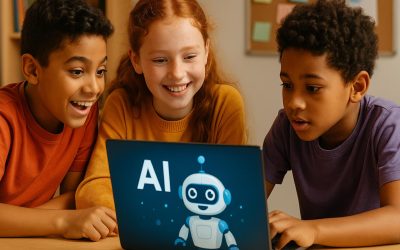In today’s rapidly evolving world, artificial intelligence (AI) and technology are becoming increasingly integrated into our daily lives. For children, this digital landscape presents both exciting opportunities and new challenges. Understanding how AI works, its benefits, and potential risks is crucial for parents and educators to guide children in navigating this world safely and smartly. This article will explore key aspects of AI and technology for kids, offering insights and practical advice for fostering a positive digital experience.
The Rise of AI in Children’s Lives
AI is no longer a futuristic concept; it’s present in many tools and platforms children interact with daily. From educational apps that adapt to a child’s learning pace to voice assistants that answer questions, AI is shaping how children learn, play, and communicate. Understanding these applications can help parents leverage technology for their child’s development.
Benefits of Technology and AI for Learning
Technology, powered by AI, offers numerous educational benefits. Interactive learning platforms, personalized educational content, and engaging STEM (Science, Technology, Engineering, and Mathematics) activities can make learning more accessible and enjoyable. For example, AI-driven educational games can identify areas where a child needs more practice and provide tailored exercises, enhancing their understanding and retention. [1]
Ensuring Online Safety and Privacy
With the increased use of technology comes the critical need for online safety and privacy. Parents must be vigilant about the content their children access, the information they share, and the security settings of the devices and applications they use. Educating children about digital citizenship, responsible online behavior, and the importance of privacy is paramount. [2]
Balancing Screen Time with Other Activities
While technology offers many advantages, it’s essential to maintain a healthy balance between screen time and other activities. Excessive screen time can impact physical health, social development, and academic performance. Establishing clear guidelines for screen use, encouraging outdoor play, reading, and face-to-face interactions are vital for a child’s holistic development. [3]
Future Skills: Preparing Children for an AI-Driven World
As AI continues to advance, the skills required for future success are evolving. Fostering critical thinking, problem-solving, creativity, and digital literacy will be essential. Encouraging children to explore coding, robotics, and other technology-related fields can equip them with the foundational knowledge and skills needed to thrive in an AI-driven world. [4]
Q&A
Q1: What are some common AI applications children might encounter?
A1: Children might encounter AI in educational apps that personalize learning, voice assistants like Siri or Alexa, smart toys, and recommendation systems on streaming platforms.
Q2: How can parents ensure their child’s online safety?
A2: Parents can ensure online safety by using parental controls, monitoring online activity, teaching children about privacy settings, and encouraging them to report anything that makes them uncomfortable online.
Q3: What is a healthy amount of screen time for children?
A3: The recommended screen time varies by age. For children aged 2-5, it’s generally advised to limit screen use to 1 hour per day of high-quality programming. For older children, a balance should be struck, prioritizing physical activity, social interaction, and sleep over screen time. [5]
Q4: Why is it important for children to learn about AI?
A4: Learning about AI helps children understand the technology shaping their world, develops critical thinking skills, and prepares them for future careers in a technology-driven society.
Sources
- The Benefits of AI in Education
- Online Safety for Kids: A Parent’s Guide
- Screen Time Guidelines for Children and Teens
- Preparing Kids for an AI-Driven Future
- American Academy of Pediatrics: Screen Time)








0 Comments